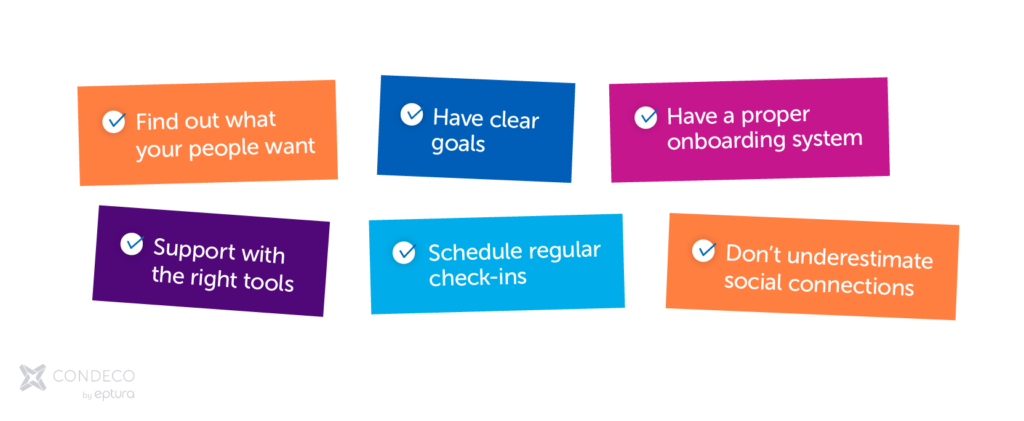
The rise of hybrid working in recent years has been seemingly unstoppable. Companies that were previously using traditional 9-to-5 models for decades have rapidly adjusted to a different reality. Whether propelled into this new arrangement by convincing evidence, employee demands, or external events, the fact is hybrid working was unfamiliar territory to many.
As a result, best practice has not circulated widely and there is uncertainty about how to support those who now find themselves working from both their home and the office. We’ve got some suggestions on how you can ensure colleagues feel happy and productive wherever they’re based, and how hybrid working can offer an even greater advantage for your business.

Find out what your people want

The starting place for any form of support is knowledge. It’s important to understand what your people actually want and where there might be gaps in what you’re currently giving them. Is the model you’re implementing right for your business or does it need tweaking?
Before you put anything in place, take a temperature check and ask everyone what they are thinking. An in-house survey is a great way to discover where your team stands on remote working. Open ended questions can tease out the challenges being faced in more detail. Rather than expecting them to fall in line, you’ll get more detail on what will make a difference to their lives.
Keep asking questions. Circumstances change, as do business challenges. Make surveys regular and thorough.
Have clear goals
Part of any support system is to provide aims and ambitions that people can focus on. Otherwise, you’re left with a group of people working hard but aimlessly.
While remote or hybrid working is often considered a job “perk,” you still need to maintain the same levels of productivity. Communicate to your staff that there are clear goals in place in terms of results, participation in meetings (both in-person and virtual), and team check-ins.
This is not being dictatorial but providing meaning and purpose that can sometimes be lost when people work away from a main team for any length of time.
Have a proper onboarding system

When new people join your business, they may not be pros when it comes to remote or hybrid working. Ensuring someone’s career with your company gets off to the right start is therefore crucial.
Hybrid working may mean that new hires might not have that traditional first day experience, complete with a full office tour and many rounds of introductions. Try to work out an in-depth schedule to ensure they still get to meet the right people either online or in-person.
Make them feel welcome, introduce them to the entire business at general meetings, and make sure you have a system in place to help them adapt to your new way of working. This likely includes training materials and cybersecurity essentials. There’s no reason why you can’t send a branded company welcome package in advance of them starting.
Conduct regular virtual check-ins during the initiation period. Don’t forget to ask for feedback on your hybrid work model.
Support with the right tools
Hybrid working makes a new set of demands when it comes to doing our jobs well. A desk and a computer is no longer the bare minimum. Make sure everyone has the right tools to succeed at home. This includes ergonomic office furniture, cloud access, and communication technology. Large projects often need close coordination and specialist software that will allow you to work in an agile manner or the approach of your choosing.
It may require a little money, but this is an important investment in the future of your business that will lead to long term results. It will help ensure that collaboration and productivity is as seamless as possible regardless of where your people are based.
Schedule regular check-ins
Managing a virtual team means staying in touch and regular face time, whether that’s in-person or virtual. Ensure that you have regular check-ins and one-to-one moments with your team, both collectively and with individuals.
This is a good practice to follow in general, but it is especially important when your people might be working in different places. These meetings can be virtual or face-to-face, although there are benefits to a mix of both. For the big discussions or annual review, in-person may be more suitable. For everyday issues, virtual meetings are a perfectly valid option.
Don’t underestimate social connections

The joy of hybrid is that you get the benefits of working from home, but you also get to retain the social connection involved with working in an office. Face-to-face meetings are important, but social collaboration – such as informal chats and bonding activities – is also essential to a cohesive workplace. Make sure you give employees the opportunities to make these connections.
Continue to organize and encourage in-office events. Happy hour activities like virtual trivia may be a bit played out by now, but there are online opportunities to bring everyone together for something less formal than a business meeting. Have social channels on Slack and Teams where people can discuss pets, children, movies, or anything else people care about. You’ll be surprised how quickly a decent book club can get going.
These things may seem trivial to the purpose of your overall business, but they’re the moments where the magic can really happen in terms of close relationships and original ideas. If you want acollaborative culture that benefits from hybrid working, then social connections are key.



